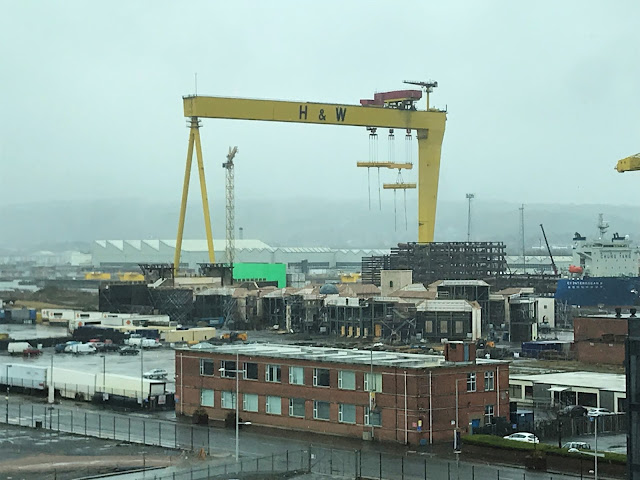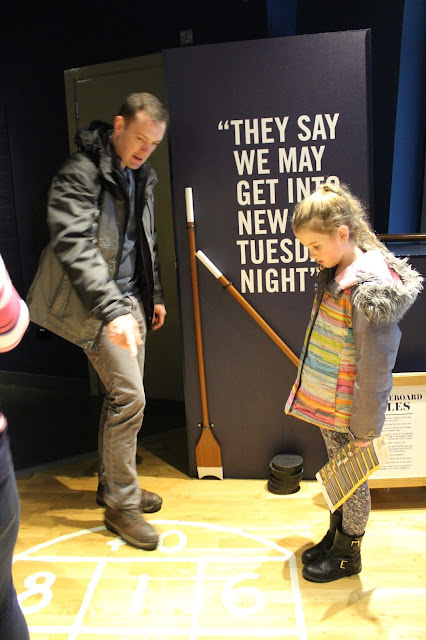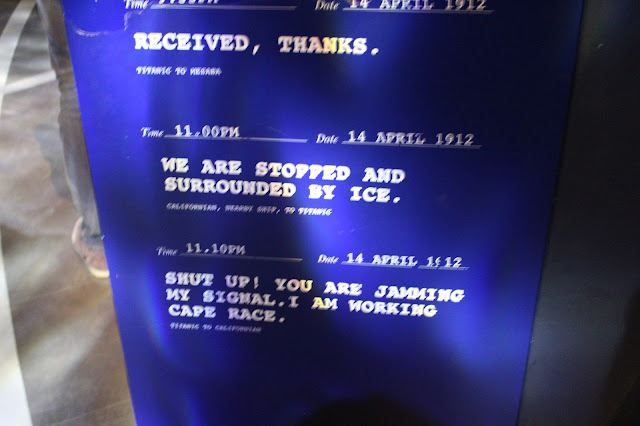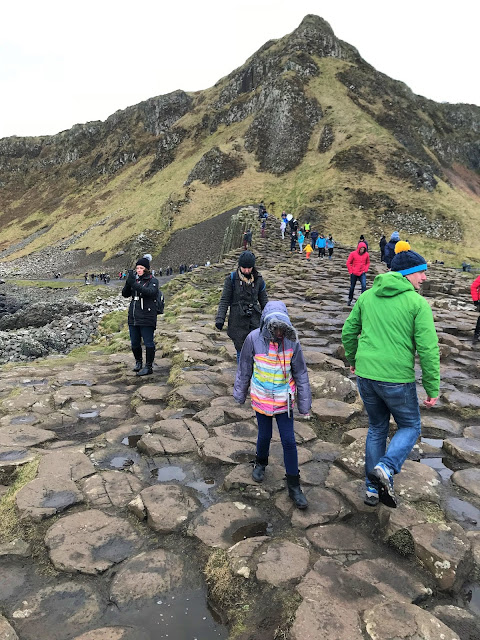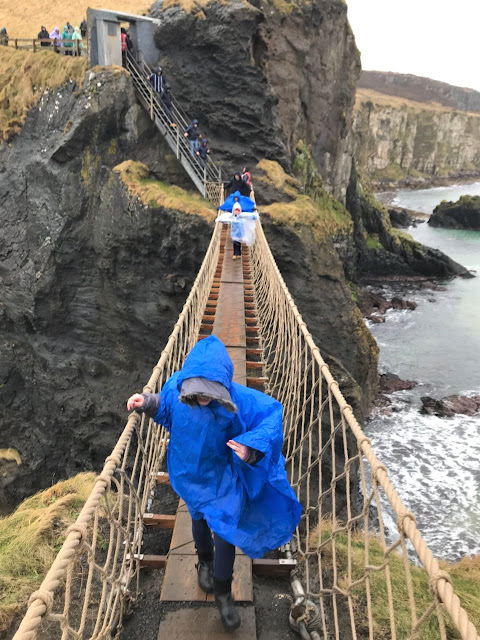Our first major trip of the year was to Northern Ireland and the Republic of Ireland! Many (ahem) years ago, Todd and I went to Ireland when we were first dating (this is how I knew I would one day marry him... because he was an excellent travel partner!) We talk about that trip a lot, still to this day. When we first started discussing our spring break plans, Natalie laid out her demands: We are either going to Ireland or Spain! I think by now you probably guessed how it came to be Ireland...
Of course, when we booked the tickets last fall, we had no idea we would be leaving on Easter. So of course, the Easter bunny made a visit to our house before we left on our mid morning flight out of Munich. Oh Grant. When will you ever give me a nice face!?!
We landed in Dublin around lunchtime so we grabbed a quick sandwich and our favorite chips (ahem... crisps!) of all time... Taytos! Taytos are the best! This little potato man makes me crazy happy. Isn't he cute!?
We had a not super stressful drive to Belfast (which takes under 2 hours from the Dublin airport which is on the north side of the city) but we still needed to immediately hit up the hotel bar for a pint of Guinness. He thinks he's super funny when he does this.
OK, that's a little better!
As is the case with the Republic of Ireland, there are a ton of cool bars all over Belfast!
Grant is obsessed with a few things right now: War ships, pugs, the game War Robot on his tablet, and goats, to name a few.
Our first destination in Belfast was, of course... a superlative! This is Belfast's oldest building - the Dirty Onion bar and the Yardbird restaurant.
My two cuties at the Yardbird restaurant in the oldest building in Belfast.
So, so frothy.
In this week's episode of "buildings in Europe that Todd does not fit in," we at least got a warning with this one! (A funny one, at that!)
Walking back to the hotel from dinner, we passed by the Albert Memorial clock. It was built in the 1860s to honor the husband of Queen Victoria, Prince Albert.
Family selfie at the Albert Memorial clock! I didn't get to see Big Ben when I was in London because it was covered in scaffolding, but this was a nice substitute.
Our first and only full day in Belfast started with the Titanic Experience! The Titanic was built in Belfast, so there is a great museum to tell all about the history of the construction. It first gives a bit of a background about how Belfast became industrialized and how the ship building industry became one of the most profitable.
I love the old tyme travel posters! And this little girl. I love her too.
Everyone was super excited about the Titanic museum but probably none more than this little guy. Here he was moving a crane around and building the Titanic!
This was the original displacement plan for the sister ships Olympic and Titanic from 1908. As you can see from the display description, it was needed to help asses the ships' weight and stability.
At the Titanic Experience, you even get to go on a Disney-esque ride! It's called the Shipyard ride, and you fly through the shipyard to see how the Titanic was built and what the conditions were like (hint: not very good!) back in the early 1900s.
As you queue for the ride, you can read quotes and facts on the walls about the Titanic. Some include, "Shipyard workers had a one week holiday in the summer and two days off at Christmas and Easter" and "The foreman was known as 'the hat' as he wore a bowler hat to mark his seniority. The bowler hat also protected him from rivets 'accidentally' dropped from above."
This was in 4D... you could feel the warmth from the fire!
The next level featured the launch of the Titanic! She was launched on May 31, 1911 and over 100,000 people were in attendance! (Not these two, though. It was a bit before their time.) A ticket cost about 2.50 pounds of today's money and proceeds went to local charities.
They actually still have a few of the original launch day tickets. This woman, Charlotte Brennan worked at the Harland and Wall headquarters. While Launch Day was on May 31, 1911, Titanic had to be outfitted so she didn't leave Belfast until April 2, 1912... 106 years to the day before we were here at this museum and only 13 days before she sank to the bottom of the north Atlantic.
Titanic Studios is where GAME OF THRONES is filmed!!!!! No. Seriously. Game of Thrones! I later saw a picture of Emilia Clark on Instagram next to the yellow and gray building on the left. Pretty cool!
A model of how big the titanic was compared to the docks, including a model of the Titanic Experience building for scale. If you know how big the building you are in is, then you can really get a sense of how large Titanic was, and how huge it must have seemed back then! Of course, by today's cruise ship standards, the Titanic is very small.
You know we love a good panorama. Here you can see directly in front of us the two (now filled in) slips where Titanic and Olympic were launched. Titanic Studios is in the background on the right.
This is one of two giant cranes known as Sampson and Goliath. They were built in 1969 and 1974 and have one of the largest lifting capacities in the whole world.
Grant standing in front of the launch site of the Titanic on a rainy day in Belfast.
They had this cool model of the Titanic and what it looked like when it was launched, before it was outfitted with all of the insides and furnishings. You can even see that the funnels and those famous life boats were missing! This is a 1:48 model.
When you walked around to the other side of the Titanic model, you could see what it looked like when it was completed.
One of the coolest things at the museum was an example of a first class cabin.
While they did not have a real example of the famous grand staircase, they did do a panorama video of the ship from the bottom up which made you feel like you were actually on the Titanic.
The example of the third class cabin was a bit... um... smaller and less grand than the first class cabin. Natalie: Mommy, what class would we have been in? Me: Third, darling.
The maiden voyage went to Southampton, then stopped in France and Ireland before setting sail on it's maiden and fateful voyage.
Playing a bit of shuffleboard on the first class deck of the RMS Titanic.
Enjoying some fresh air and listening to the seagulls with Daddy on the Titanic.
Nothing but open seas and smooth (!!!) sailing ahead!
OMG STOP. That is so, so, so gross. "Before boarding, 3rd Class passengers were subjected to one final medical examination. Using a ladies button hook, every immigrant had their eyelid turned back on itself. The doctor undertaking this procedure was looking for any traces of the highly contagious eye disease trachoma."
... Unless it's America and it's 2018. Then we build walls.
The next room was all about the actual sinking of the ship. Titanic to Californian as California tried to warn them about ice: "Shut up! You are jamming my signal. I am working Cape Race." Jack Phillips, the wireless operator was busy sending out personal messages from passengers through Cape Race, Newfoundland who sent them onto New York. Titanic made it's famous iceberg hit only 15 minutes later.
You got to see a video portraying the sinking. Grant tells us this was technically accurate. He gets very upset when things are not technically accurate regarding the Titanic's sinking.
There was a giant floor to ceiling theater screen showing one of the explorations of the Titanic wreckage.
I think she's ready to dive into the OEC, which I think meant Ocean Exploration Center. They had a little exhibit on the bottom floor about other underwater explorations.
This was Captain Smith's personal bathtub found among the wreckage.
Rose and Jack 2gether 4 ever.
How is it the kids took the nicest picture I've probably ever seen of them together and their parents ruined it!?! You know we love these silly little pictures!
Even though it was pouring and the wind was blowing so hard that the kids were getting knocked over, we had to see the world's last remaining White Star Line vessel, the SS Nomadic! The Nomadic used to tender for Titanic and although it's been moved around a bit over the years (like how it served as a bar on the Seine in Paris for some time), but recently they've restored it to its original glory.
A little boy who loves ships next to the SS Nomadic. He will tell you that SS stands for "Steam Ship." While HMS stands for "Her Majesty's Ship" and RMS stands for "Royal Mail Ship."
They're on the Nomadic, ready to be taken to board the Titanic.
The "grand" staircase of the SS Nomadic.
They have a little area where passengers could get a coffee, and a virtual waiter who was telling us about the Nomadic.
Ring For Service. Pierre will serve you.
You could even try on some clothes from the time of the Titanic. The kids didn't feel they were cool enough to try on some 1910s fashions, but you know the big kid didn't mind!
High fashion fake tea party, complete with the pinky out.
She's so prim and proper, ladies and gentlemen.
It was coming down pretty good when we went to the top deck of the Nomadic, but he didn't care. Although it's not here at the ship, one lifeboat remains (and was restored) and is currently the only White Star Line lifeboat still in existence. Most of them, of course, are on the bottom of the Atlantic.
Driving the Nomadic in the rain and howling wind.
That wheel is bigger than he is!
In fact, it's only slightly smaller than the big kid! She's driving the ship straight for the Titanic Experience museum!!
Ummm, wrong boat. You saw the movie, right?
After some quick sandwiches back over at the Titanic museum, we hurried over to Commercial Court to the Duke of York pub. Commercial Court is so cute!
How fun is this street?
I love this three dimensional street!
We rushed over to this area because we were supposed to meet with the driver from Black Cab Tours at 2:00 but we apparently rushed a little TOO much, because we got there with enough time for a beer at the Duke of York.
EEEEK! One of my favorite bands had their first gig here at the Duke of York back in 1998!
Leaving Commercial Court... Dali in lights?
He didn't tell us his name until after the tour, but we met up with our driver Sean from Black Cab Tours for a... well... a Black Cab Tour of Belfast! You can pick the itinerary, and the driver will tailor the tour to your interests. We wanted to know more about the Troubles, and let me tell you... Sean knew his stuff! I highly recommend Black Cab Tours! You could probably do a dozen tours of Belfast and still not learn everything about it.
This is gonna be a little long, but this is the history of the Troubles, condense from three hours to just a few short paragraphs.
To know the history of the Troubles, which lasted from 1968-1998, you need to go all the way back to the 1600s when England was sending Scottish Anglican Protestants over to Ulster (what we know as Northern Ireland today) to colonize unpopulated areas of what is mostly County Antrim and County Down today. This of course, caused an immediate problem between the new English/Scottish protestants and the Irish Catholics which led to a couple of wars in the mid and late 1600s. Penal Laws limited and repressed the right to practice any non-Anglican religion freely, as well as limited the education and land owning rights of anyone who wasn't Anglican.
In 1801, Ireland became a part of the United Kingdom again and it's parliament had been abolished. In 1829, the Catholic Relief Act was passed which repealed any remaining Penal Laws and the Roman Catholics of Ireland were finally free. But by the late 1800s, the Irish Catholics were rallying for a reinstatement of the Irish Parliament.
This leads us to the early 1900s when, in 1916, the Easter Rising occurred in Dublin. Irish Republicans protested in Dublin for an independence from England, led by James Connelly and Patrick Pearse. Unfortunately, only about 1,200 Republican fighters showed up for the uprising, and although the battles with the British Army were bloody and the Republicans had to surrender, more British soldiers were killed than Irish Republican soldiers. Many rebels were imprisoned, including some who had no part in the uprising, which led to anger among the Irish Catholics. Fifteen leaders of the uprising were executed by firing squad at Kilmainham Jail. What did this make them? Martyrs, of course. And it led to the rise of the Sinn Fein party. Finally, in 1920, Ireland was once again independent from the UK. However, this time, it was separated into two separate countries: Northern Ireland, which still belonged to the UK, and the Republic of Ireland which was an independent country. The border was formalized after the Irish Civil War of 1922-1923.
Probably the most interesting thing I learned on this tour was that in the 1960s, with the advent of television, the Irish were watching the American civil rights protests play out on the nightly news. They realized that if these sorts of protests were effective at gaining civil liberties for a subset of the American population, they could possibly be effective in Ireland as well.
How do you know that we are in a Republican neighborhood? The Irish flag flies proudly here, and is shown in some of the murals. You can see the green, white and orange of the flag in this mural, as well as the typical Celtic cross that is used in cemetery plots. In the Loyalist neighborhoods, the Union Jack is flying.
In the early 1970s, violence exploded across Northern Ireland. People were randomly killed on the streets just for being Loyalist or Republican. Segregation between these two groups became increased. The famous "Bloody Sunday" occurred in 1972 when 13 unarmed men were shot dead by the British Army at a rally in Derry.
In early 1973, six Catholics (see the flags?) were killed by the British Army and the Ulster Defense Association. None were ever charged or convicted of these murders.
This was one of the most perplexing murals we saw. This was in memory of Lt. Jackie Coulter. He was a member of the Ulster Defense Association, a paramilitary group of loyalists. He was murdered by a member of the Ulster Volunteer Force, which were also paramilitary loyalists. The insanity of the Troubles wasn't just limited to the feud between Loyalists (Protestants) and Republicans (Catholics.) The Troubles led to doubt and terror and skepticism even among groups on the same side.
Loyalist murals remember the riots in the summer of 1969 in Lower Shankill.
Many of the more recent murals were painted with the permission of the owner who's home happened to be at the end of the row of townhomes. They also feature less propaganda, and more memorials. Back before the Peace Agreement, you did not have a choice to have your wall painted with propaganda scenes. Notice the smaller painting to the left of the two men with machine guns that says, "The Land of the Free Because of the Brave." No matter where you drive or stand around this, those machine guns are painted so that they are always pointed at you.
Toward the end of our tour, Sean stopped at the wall that still exists between the Falls Road area and the Shankill Road area. The Peace Wall was erected on Cupar Way to deter people from throwing bricks, rocks and even grenades over the top to the opposing neighborhood. As you can see, the wall was built, then added onto, and then added onto again as people found more creative ways to toss objects over the wall. You're allowed to graffiti it, but it was pouring rain, so despite our best efforts, we weren't able to do much.
Clinton gets lots of love in Northern Ireland as the 1998 Good Friday Peace Agreement happened under his administration, although George Mitchell, the US Envoy to Northern Ireland brokered the agreement.
Sean talking to the kids about the wall and what it meant to Belfast.
Family photo in the rain at the Peace Wall in Belfast after we tried to doodle on it.
Sean then took us to the other side of the wall: The Catholic side. Notice how the wall isn't covered in graffiti, and the homes have cages around the back side which would prevent major damage to their homes in the event of a grenade. Even though it's been 20 years since the Peace Agreement, people clearly don't feel safe enough to take down this metal cage, or the wall for that matter.
The Tribute to Bobby Sands and other members of the 1981 hunger strike. They protested the conditions in the prison, and for the right to not have to wear a prison uniform, as well as to have one parcel and letter per week, the right to not have to do prison work, and the right to associate with other prisoners. They felt they were political prisoners, not actual criminal prisoners and therefore should be treated as such. In all, 10 men died in the hunger strike.
I'll wear no convicts uniform, nor meekly serve my time that Britain might make Ireland's fight 800 years of crime...
What was supposed to be an hour and a half tour turned into nearly three hours of Belfast history. And why didn't Sean tell us his name until after the tour? Because his name tells you which side he was on. Names like Sean and Patrick tell you he was a Republican. Names like William and James would tell you the man was a Loyalist. He didn't want our knowledge of his background to have any affect on impartiality.
After our excellent three hour tour of Belfast, we went to the Crown Bar to see if we could get something to eat. They have the most beautiful doors! It was really crowded so we went next door and upstairs to Robinson's.
Across the street from where we were eating was the famous Europa Hotel. It's famous for having been bombed more times than any other hotel in history. It was bombed 36 times during the Troubles!
We had SO much fun at this dinner and I don't know why. We laughed so hard, played games, ate and drank well and even had dessert!
The best part about staying at a Holiday Inn Express is definitely the free breakfast! We had a really busy final day in Northern Ireland planned so we had to fill our bellies before hitting the road.
Our first yet very brief stop was the Dark Hedges, which is famous for being in Game of Thrones as the Kings Road. Arya and Gendry took this road with many others as they made their way to the Wall and Castle Black.
This pedestrian only road is literally in the middle of fields. You have to park at the nearby Hedges Hotel and walk the short walk to Bregagh Road but it's free to do both!
These beech trees were planted in the 18th century and the road used to be the driveway to Gracehill House, a manor built in 1775 by the Stuart family.
Eventually this road was no longer the Stuart driveway but the beech trees still stand. It later became a pedestrian only way to preserve the trees.
It's really just a beautiful road. You have to get there really early if you want pictures without any other humans in it though. I was playing around with the lighting on my camera for some of these pictures.
He's a little tree hugger.
This wasn't even the Dark Hedges road... it was Ballinlea Road, but looked equally as eerie!
Our second stop of the day was the Giant's Causeway along the Antrim Coast.
The Giant's Causeway is made up on thousands of basalt columns which were originally made of lava, but cooled by the water and chilly air of northern Ireland they condensed and formed hexagonal shaped columns.
Taken from the Giant's Causeway Heritage Site: The myth goes something like this… Finn MacCool (or Fionn MacCumhail in Irish), an ancient mythical giant created the Giant’s Causeway as a means of getting across the channel to face his rival, the Scottish giant Benandonner. The effort of constructing the Causeway exhausted Finn so he fell asleep before he could cross to meet his rival. Before he woke Bennadonner used the Causeway to bring the fight to Finn. Finn’s wife Oona covered him with a blanket, telling the Scottish giant it was their baby son. Bennadonner took one look at the size of the baby and fled the scene fearing to face the father of such an enormous infant. Benandonner ripped up the Causeway as he fled, leaving only the coastal remnants at the Giant’s Causeway and Fingal’s Cave on the Scottish island of Staffa.
The entire coastline is really beautiful. It would have been even more beautiful if it hadn't started pouring rain and hadn't been really cold!
Walking the columns isn't for the faint of heart or for those in poor physical health. They were also slippery due to the rain.
Notice how far up the basalt columns go and how far they curve around to the left in the above photo.
This reminds me a lot of the basalt column formation at Parkstein, Germany, not too far from where we live. Check out our trip to Parkstein a couple of years ago, here.
At one point, Todd and the kids are the only people out there, except for the guard who keeps people from going out too far on the rocks.
While we waited in the rain for the bus, Todd took a quick look on the other side of the columns. Look how cool these formations look! I'm totally geeking out with these cool geologic formations!
Panorama of wicked cool basalt formations on the Antrim Coast.
We had a little lunch at the nice restaurant at the Causeway Hotel right next to the visitor's center. Natalie asked Grant to draw a picture of her and this is what he came up with. He's such a little jokester!
Driving to our next destination the Carrick-a-Rede bridge which is east of Giant's Causeway, you partially drive along the beautiful coastline.
The walk from the parking lot to the Carrick-a-Rede (pronounced "Carrick ah reedy") rope bridge is just stunning. It's a pretty easy walk, even in the rain.
There's a nice little grassy hill on the land side of the path to the bridge, and it's dotted with little sheep.
Like I said, the walk to the bridge is really pretty. You can see Rathlin Island in the distance (not a part of Scotland, as we initially thought!)
It was a good thing we brought rain gear because the rain was coming down by the time we got here!
The bridge, in the distance behind Natalie connect the mainland to the small island of Carrickarede when fisherman needed a passage way in order to do salmon fishing in the summer months.
It looks a bit like the Cliffs of Moher, which we were set to see in a couple of days.
After about a half a kilometer walk, you finally approach the bridge. The bridge itself is about 66 feet long and about 98 feet high. One hundred feet doesn't seem very high until you're on a roughly two plank wide rope bridge that is swaying in the wind.
Wait. You want me to cross THAT? Go watch Rick Steves in Northern Ireland and watch his reaction when he crosses this bridge. It's definitely accurate.
I love the guy in front of us just walking all casual across the bridge.
Todd and Nat screamed across the bridge, but you can see I got stuck behind Grant who was walking slower. (OH MY WORD I LOVE YOU BUT PLEASE SPEED UP!) It's also a one way bridge, so they have workers on both sides directing traffic and making sure that the weather conditions are ok for crossing. As you know, the weather can change pretty rapidly!
I'm practically hunched over because I swear the guy behind me was stomping across the bridge and it was really wobbly. Once you get to the island, you have to walk across the bridge again to get back. Apparently there have been a few people who have crossed to the island and have simply been unable to walk back across to get home, so they send a boat to pick them up!
Caves down below the cliffs with really green water.
Todd took this panorama from the island, looking back at the mainland. You can see the bridge on the far right.
They have a little example of a fishing boat and how the locals would have used the island in order to fish for salmon.
We crossed the bridge back to the mainland and because of the cold, my phone died (plugged it back in at the car and it immediately went back to 40% of course.) So I didn't really get any pictures of Todd crossing the bridge. I feel really bad about that! The views on the mainland from the east side were definitely the best.
A zoomed in look at the bridge with humans for scale.
We drove back to Belfast and at the end of the day, walked to an Italian restaurant for dinner that was really good called Scalini. It was a nice end to a cold and wet day!
Until next time, Northern Ireland!























